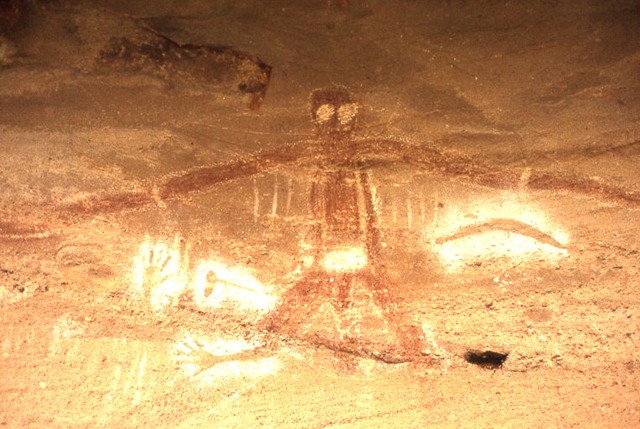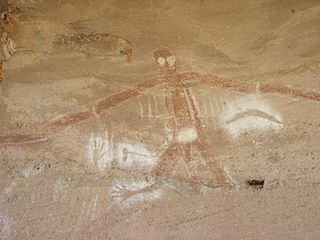


Australian Hero Gods
Wurrunna
In Australian Aboriginal mythology, Wurrunna is a culture hero.
The Dreamtime story of the black swans tells how two brothers were turned into white swans so they could help an attack party during a raid for weapons. It is said that Wurrunna used a large gubbera, or crystal stone to transform the men. After the raid, eaglehawks attacked the white swans and tore feathers from the birds. Crows who were enemies of the eaglehawks came to the aid of the brothers and gave the black swans their own black feathers. The black swan red beak is said to be the blood of the attacked brothers, which stayed there forever.[1]
I'wai
In Australian Aboriginal mythology, I'wai is the culture hero of the Koko Y'ao. I'wai was a crocodilian man who brought most of the Koko Y'ao religious rites and ceremonies.
Crow (Australian Aboriginal mythology)

Australian raven (Corvus coronoides)
In Australian Aboriginal mythology, Crow is a trickster, culture hero and ancestral being. In the Kulin nation in central Victoria he was known as Waa (also Wahn or Waang) and was regarded as one of two moiety ancestors, the other being the more sombre eaglehawk Bunjil. Legends relating to Crow have been observed in various Aboriginal language groups and cultures across Australia.[1]
Contents
[hide]
Crow steals fire[edit]
One common myth concerns Crow's role in bringing fire to mankind. According to a version of this story told by the Wurundjeri people of the Kulin nation, in the Dreamtime fire been a jealously-guarded secret of the seven Karatgurk women who lived by the Yarra River where Melbourne now stands. These women carried live coals on the ends of their digging sticks, allowing them to cook yams. One day Crow found a cooked yam and, finding it tastier than the raw vegetables he had been eating, decided he would cook his food from then on. However, the Karatgurk women refused to share their fire with him and Crow resolved to trick them into giving it up.[1][2]
Crow caught and hid a number of snakes in an ant mound then called the women over, telling them that he had discovered ant larvae were far more tasty than yams. The women began digging, angering the snakes, which attacked. Shrieking, the sisters struck the snakes with their digging sticks, hitting them with such force that the live coals flew off. Crow, who had been waiting for this, gathered the coals up and hid them in a kangaroo skin bag. The women soon discovered the theft and chased him, but the bird simply flew out of their reach and perched at the top of a high tree.[1]
Bunjil the Eaglehawk, who had seen all of this, asked Crow for some of the coals so that he could cook a possum. Crow instead offered to cook it for him. Soon, a large group had gathered around Crow's tree, shouting and demanding that he share the secret of fire with them. The din frightened Crow and at last he flung several live coals at the crowd. Kurok-goru the fire-tailed finch picked up some of the coals and hid them behind his back, which is why to this day firefinches have red tails. The rest were gathered up by Bunjil's shaman helpers, Djurt-djurt the nankeen kestrel and Thara the quail hawk.[1]
The coals caused a bushfire which burnt Crow's feathers permanently black and threatened to consume the entire land, until Bunjil's efforts halted its spread. The Karatgurk sisters, meanwhile, were swept into the sky where they became the Pleiades (the stars are said to represent their glowing fire sticks).[1][3]
Crow and Magpie[edit]
The various groups of Western Australia offer two versions of the same story about the Crow and the Magpie. The crow and the magpie are brothers,[4] both born with pure white feathers.[5] Both were vain and would argue as to which was the most beautiful. Perched in a tree, they began to argue and then fought.
The people with the crow as their totem will tell you the brothers fell into a fire below, the Crow getting burnt all over, the Magpie only partly burnt. Those whom have the magpie as their totem will tell the story the same, but that the brothers fell into thick black mud, and the magpie only slightly stained his feathers, the crow covered in the mud.
As for the crow, as in all Indigenous Australian totems, it is known for its cunning and intelligence, a trickster too, and old spirit with prescient knowledge or carrying old knowledge of many lifetimes (like reincarnation). Very powerful too, as in the totem itself is one of the ones with powerful natural magic, and depending on the language groups own mythology the holder of the totem will either carry great respect, or suspect.
Crow and Swamp Hawk[edit]
In another legend, Crow was travelling down the Murray River when he met Swamp Hawk.[6] Deciding to play a trick on the other bird, he planted echidna quills in the deserted nest of a kangaroo rat and enticed Swamp Hawk to jump on them. The quills stuck and grew into Swamp Hawk's feet, but the bird was pleased with this as he found he was now able to catch rats more easily.
Some accounts have Crow ultimately leaving the earth altogether, having been called up into the heavens where he became Canopus, the second-brightest star in the night sky.[1]
Crows attacking spirits on the way to the afterlife[edit]
The Yanyuwa people have a legend that says that as spirits of the dead approach the afterlife, they are attacked by crows carrying digging sticks. The crows are said to be angry with all people because people often chase them away from campsites when they scavenge. The spirits are saved by hawks and falcons.[7]
Notes[edit]
- ^ Jump up to:a b c d e f Mudrooroo (1994). Aboriginal mythology: An A-Z spanning the history of the Australian Aboriginal people from the earliest legends to the present day. London: Thorsons. pp. 35–36. ISBN 978-1-85538-306-7.
- Jump up^ W. H. Edwards (1988). An Introduction to Aboriginal Societies (2 ed.). Social Science Press. p. 32. ISBN 1876633891.
- Jump up^ The Kanatgurk and the Crow, from Australian Dreaming: 40,000 Years of Aboriginal History (1980) Comp. Jennifer Isaacs, Lansdome Press, Sydney, NSW, pp. 107–108, reproduced at The Kanatgurk and the Crow, New South Wales Government, archived from the original on 7 July 2014
- Jump up^ The Crow and the Magpie, from Aboriginal Legends from the Bilbulman Tribe (1981) Eddie Bennell and Anne Thomas, Rigby, Australia, pp. 19–20, reproduced at The Crow and the Magpie, New South Wales Government, archived from the original on 6 July 2014
- Jump up^ Hancock, Peter (5 April 2014). "Ancient tales of Perth's fascinating birds". The Sydney Morning Herald. Fairfax Media. Archived from the original on 25 January 2015.
- Jump up^ Crow, Aboriginal Mythology (1994) Mudrooroo, Thorsons, London, pp. 35–36, reproduced at Crow (Waa Wahn), New South Wales Government, archived from the original on 7 July 2014
- Jump up^ Philip Clarke (2007). Aboriginal People and Their Plants. Rosenberg Publishing. p. 29. ISBN 9781877058516.
Baiame

Wonnarua painting of Baiame, near Milbrodale, (south of Singleton, New South Wales). Note that his arms extend to the two trees either side.
In Australian Aboriginal mythology Baiame (Baayami or Baayama or Byamee) was the Creator God and Sky Father[1] in the dreaming of several language groups (e.g. Wonnarua, Kamilaroi, Eora, Darkinjung, and Wiradjuri), of Indigenous Australians of south-east Australia.
Contents
[hide]
Description and history[edit]
The Baiame myth tells how Baiame came down from the sky to the land, and created rivers, mountains, and forests. He then gave the people their laws of life, traditions, songs, and culture. He also created the first initiation site. This is known as a bora; a place where boys were initiated into manhood. When he had finished, he returned to the sky, and people called him the Sky Hero or All Father or Sky Father.[2]
He is said to be married to Birrahgnooloo (Birran-gnulu), who is often identified as an emu, and with whom he has a son Daramulum (Dharramalan). In other stories Daramulum is said to be brother to Baiame.
It was forbidden to mention or talk about the name of Baiame publicly. Women were not allowed to see drawings of Baiame nor approach Baiame sites—which are often male initiation sites (boras).
In rock paintings Baiame is often depicted as a human figure with a large head-dress or hairstyle, with lines of footsteps nearby. He is always painted in front view; Daramulum is drawn in profile. Baiame is often shown with internal decorations such as waistbands, vertical lines running down the body, bands and dots.
Link with the Christian God[edit]
The missionary William Ridley adopted the name of Baiame for the Christian God when translating into Gamilaraay (the language of the Kamilaroi). It is sometimes suggested that Baiame was a construct of early Christian missionaries. Doubt is cast on this by a reference to Baiame apparently dating back to 1830-1840 by K Langloh Parker.[3]
Portrayal in the Lake Macquarie Area[edit]
In the area surrounding Lake Macquarie in New South Wales, Australia,[4][5] he was believed to have created all of the mountains, lakes, rivers and caves in the area. After he finished creating, he jumped back up to the spirit world from Mount Yengo, which he flattened. Its flat top can still be seen to this day, near Wollombi Valley.[6] A cave near Milbrodale contains many wonnarua Aboriginal paintings, including a large figure of a man who may be Baiame. It is popularly known as the Baiame Cave and is part of a series of rock shelters on an area of 80 hectares. The site is listed on the Register of the National Estate.[7] It depicts him with enormous, long, arms and large staring eyes.
Significance[edit]
During the Stolen Generation many tribes lost information about their culture, traditional beliefs, stories and ceremonies, and because Aboriginal customs were not written down and recorded, the effect of the Stolen Generation affected all. To the several local tribes, the Wonnarua, Wiradjuri, Darkinjung, Awabakal, Worimi, Biripi, Wailwan and Kamilaroi, it is another piece to the puzzle, helping them uncover lost ceremonies and traditions.
See also[edit]
References[edit]
- Jump up^ Aboriginal Art of Australia, Baglin (Mulavon) 1986, p.11
- Jump up^ "Footprints on Rock", 1997, Sydney: Metropolitan Local Aboriginal Land Council. ISBN 0-7313-1002-0
- Jump up^ Parker, K. Langloh (1905). "The All Father, Byamee". The Euahlayi Tribe: A Study of Aboriginal Life in Australia (1 ed.). London: Archibald Constable and Company. pp. 4–10.
- Jump up^ Wright.T- Belongs the Kamilaroi people
- Jump up^ Yengo National Park
- Jump up^ Wollombi Valley History
- Jump up^ The Heritage of Australia, Macmillan Company, 1981, p.2/211
Julana
| This article relating to a myth or legend from Australia is a stub. You can help Wikipedia by expanding it. |
In Australianaboriginal mythology (specifically: Jumu), Julana is a lecherous spirit who surprises women by burrowing beneath the sand, leaping out, and raping them. He was alive, and wandered the Earth with his father, Njirana, during the Dreamtime.
 |
This article about a deity is a stub. You can help Wikipedia by expanding it. |

